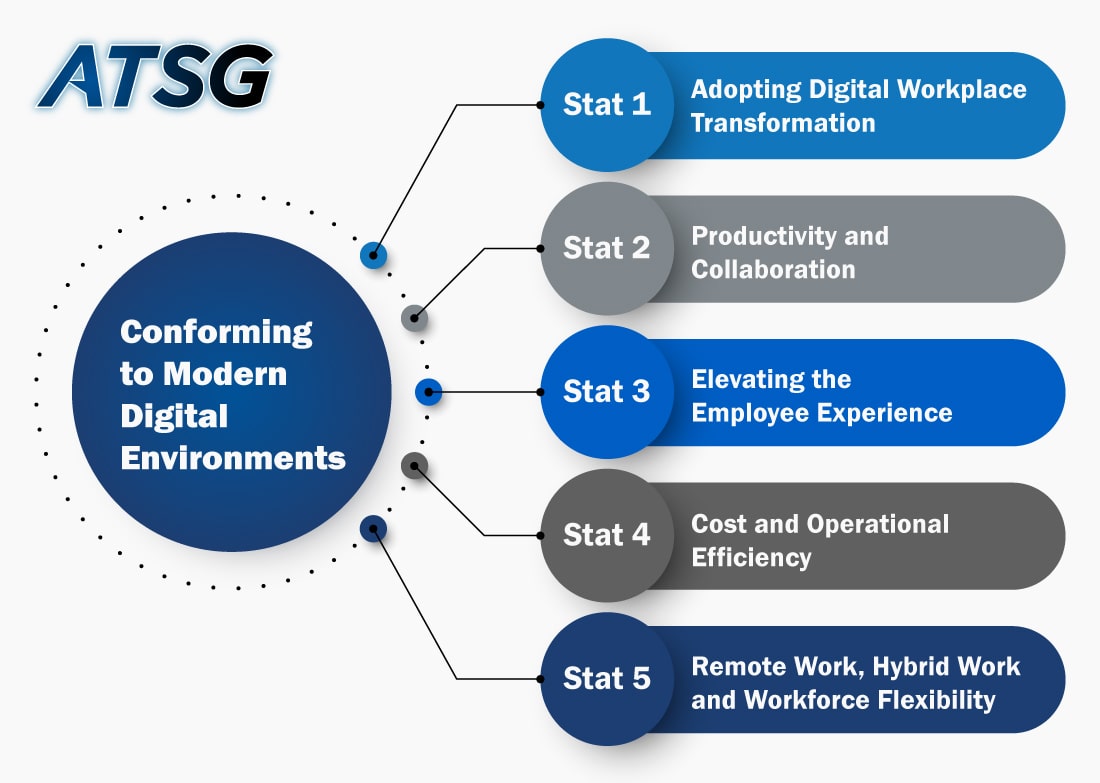With the shift towards automation and digital solutions, businesses have started to accelerate their efficiency in multiple ways. Surveys show that 74% of businesses are already adopting automated solutions. Artificial Intelligence (AI) and automated technologies are predicted to attain a global value of US $15 Trillion by 2030.
As workplaces become more digitalized, the entire organization can communicate and collaborate more efficiently and flawlessly. A digital workforce allows businesses to form productive relationships, and cater to knowledge sharing across the organization. Workforce transformation is vital in empowering businesses, and leading toward a digital future.

Discovering Digital Workplace
The trends driving digital workplaces began way before the pandemic. The emergence of cloud services, software as a service (SaaS), artificial intelligence (AI), and Internet of Things (IoT) technology further accelerated digital transformation.
Conforming to Modern Digital Environments
Employees and recruits now look for opportunities in remote work environments. Enterprises need to assemble robust solutions and flexible workplaces to meet employee needs. With digital transformation, organizations have to adopt a people-centric approach to workplaces. To provide what employees need and optimize work productivity, digital workplaces need to be central to every organization today.
Now that we have made a strong case for Digital Workplace Transformation, let us discuss some insightful statistics around this domain, and also the emerging trends for year 2023.

Stat 1: Adopting Digital Workplace Transformation
Digital transformation is happening at a strong pace across the globe. The vast majority of organizations have some initiatives in place, and the pandemic has only fuelled this change. Enterprises have begun to invest in digitalizing workplaces through technological means.
There are several statistics that promote the concept of digital workplace transformations, as 95% of organizations agree that a digital workplace is important. At its core, digital workplace transformation creates an environment where people can work together with greater trust and transparency.
The International Data Corporation (IDC) predicts that by 2023, 60% of the Global 2000 businesses will deploy AI and ML enabled platforms to support the entire employee life-cycle, from on-boarding through retirement.
Benefits of Digital Workplace Transformation
The modern workspace is ever-evolving. With time, the needs and demands for productivity, efficiency, and worker satisfaction are growing. Businesses can achieve greater success by making changes that prioritize employees, developing new tools to streamline processes, or even introducing a flexible working environment.
Here are some benefits of Digital Workplace Transformation:-
- Improved Efficiency and Productivity: Businesses can increase their efficiency and productivity by improving team dynamics, introducing new technologies, and creating better working conditions through workplace transformation.
- Engaging Work Environment: Through digital workplace transformation, businesses can create an engaging and positive atmosphere that increases morale and fosters creativity. This increases employee loyalty, as they feel more valued in their work environment.
- Higher Employee Satisfaction: Businesses can increase employee satisfaction over time, by digitizing workspaces, instituting flexible working arrangements, and introducing more opportunities for collaboration. This leads to improving retention rates, better performance, and a healthier bottom-line.
Stat 2: Productivity and Collaboration
One of the major reasons behind digital transformation in workplaces is to establish strong productivity levels, and invest in collaborative tools. With the help of technology and digitalization, organizations are better able to fulfill these demands. According to surveys on improving productivity levels amongst employees, 74% chose communication tools, and a similar 74% mentioned collaborative platforms.
Moreover, 40% of executives believe that the top anticipated benefit of adopting a digital model is improved operational efficiency. The increase in productivity with automating processes through digital transformation has converged tasks that were previously done manually.
How Remote Collaboration Streamlines Workflows?
Digital collaboration is helping enterprises with managing and strengthening their teams, enabling them to improve workflows across all domains. The following list explores ways that digitalization can help with collaboration and productivity.
- Improved Team Interaction:
Digital collaboration plays a huge role in improving team interaction, especially among geographically dispersed team members. There are software tools that can be used to carry out discussions, accompanied by screen sharing and video chat. So, no matter where the team members are in the world, the workflow is maintained by Digital collaboration with meaningful interactions. - Seamless Access to Information:
Digital collaboration in the workplace improves workflows by making sure employees have access to the right files and content at the right time. The digital workplace provides a central location for all files, documents, web links, and other material. This makes it extremely easy for team members, irrespective of their locations, to access information from any device. - Improved Process Execution:
With the mobile-first approach of communication and collaboration, employees can be in the loop anytime they want. When employees are well aware of what’s happening in the company and have the right tools, they are left with much-needed space to brainstorm, and think of better ways to move the business forward. - Knowledge Sharing:
Digital workplace tools, like knowledge management systems, allow organizations to document the know-how and experience of senior managers. With this approach, the knowledge base of the organization remains intact, even if some employees leave. With a knowledge management system in place, the business or future employees can easily access this information, and continue doing their work with ease. - Increased Team Productivity:
Digital collaboration can help increase productivity, by getting rid of commute time, and the time spent on other administrative tasks. This allows team members to work on the same document collaboratively.
Stat 3: Elevating the Employee Experience
Digital transformation of workplaces also requires a strong sense of commitment, and a skilled workforce that can elevate the experiences and outcomes of the business. According to a survey, organizations with higher levels of employee engagement were 21% more profitable than those with lower scores. Businesses with highly engaged workforces were also 17% more productive.
Benefits of Technology for Employees in Digital Workplaces
The importance of technology in the workplace cannot be understated. It is the core component of any modern-day organization’s workforce success. The following is a list of benefits that technology provides in improving the employee experience.
- Competitive Growth:
With rising consumer demands, the impact of technology enables workforces to improve their performance and speed. This further helps employees achieve stability and progress with the latest technologies, and investments made across the organization. When both employees and customers are satisfied, it increases the chances for profitable growth. - Communication and Collaboration:
Technology has made communication easy in today’s workplaces, irrespective of working from home (WFH). Technology increases productivity for an organization and its employees, as feedback on a specific project or task can quickly be shared over multiple mediums. Employees feel more comfortable when they have accessibility to the tools which can elevate their performance at work. - Increased Security:
With the rise of cybersecurity challenges, it is important for organizations to prioritize infrastructure and device security. With technology, organizations develop multiple security layers and mechanisms that offer robust protection. - Improved Productivity:
Technology provides the ability to automate tasks and eliminate the chances of human error. This leads to employees being able to work seamlessly without any disruptions. Due to this digital shift, employees can focus on more important tasks that generate revenue, and drive the company forward. - Investing in the Right Technology:
Change within an organization can steer the employee experience (EX) in the right or wrong direction. Investing in the right technology is key to adopting change seamlessly. Finding appropriate technology solutions to transform workplaces and EX helps organizations gain a competitive advantage.
Stat 4: Cost and Operational Efficiency
Digital transformation has become an essential strategy for businesses to stay competitive, and thrive in today’s rapidly changing business landscape. It involves leveraging technology to improve business operations, increase efficiency, and ultimately reduce costs. Up to US $1.5 Trillion was spent on digital transformation in 2021 alone. With an expected cumulative growth rate of 9.1% over the next five years, global spending on digital transformation may reach US $6.8 Trillion by the end of 2023.
For businesses that can afford it, and are willing to invest in digital transformation, the potential to reduce cost and increase revenue is immense. According to an IDC report, it was revealed that start-ups could boost their revenue by as much as 34%, just by adopting digital strategies.
Cost and Operating Benefits of Digital Workplace Transformation
Contemporary businesses are embracing digital transformation to keep up with latest market trends. It’s only a matter of time before businesses and workflows are digitized for the betterment of companies, employees, and clients.
The following list explores the benefits of digital transformation in terms of cost and operational efficiency.
- Enhancing Operating Procedures:
Use of digital tools like project management, software and task management, help organizations to produce, coordinate, and operate efficiently. - Efficient Decision Making:
As a result of digitalization, organizations can also improve their decision-making processes. With digital metrics, key performance indicators (KPIs) and data from companies and customers, the company’s decision-makers can be guided towards better solutions. Modifying products and services is also possible with the help of tracking sales. - Saves Operating Costs:
Business digitization reduces operating costs, because organizations can forgo conventional office supplies and other manual machines. Further, organizations can also opt for other methods with effective production control and sale processes. - Improved Productivity:
Adopting a digital culture can help reduce time spent on processes, eliminate mundane tasks, and add new functionalities or strategies that add value to the enterprise. Something as simple as automating critical steps in business processes can save a huge overhead cost for an organization.
Stat 5: Remote Work, Hybrid Work and Workforce Flexibility
Post-pandemic, many organizations had to conform to remote working models, as employees found it more convenient. A variety of designations and roles can operate from remote locations, without the need for being present in the office. According to Gartner, around 80% of organizations worldwide allowed their employees to work from their homes during the pandemic.
Developing the Digital Culture for Remote Workplace Success
One of the key elements in managing distributed remote workforces is to establish a consistent culture. The impact of developing an adaptable corporate culture is to encourage growth and flexibility across the entire organization, irrespective of distance and location. This is exactly what digital workplace transformation helps enterprises to achieve.
Choosing the Best Service Provider
Today’s fast-moving world means that companies have to implement digital workplace solutions, or risk losing to the market competition. However, a lot of organizations are struggling to find the suitable resources and tools to attain digital workplace transformation. ATSG’s Desktop as a Service (DaaS) solutions can prove the perfect catalyst for your digital workplace transformation.
Contact ATSG for best in class Managed IT Services, Intelligent Technology Solutions, Cybersecurity Services and Cloud Computing solutions for your enterprise.




